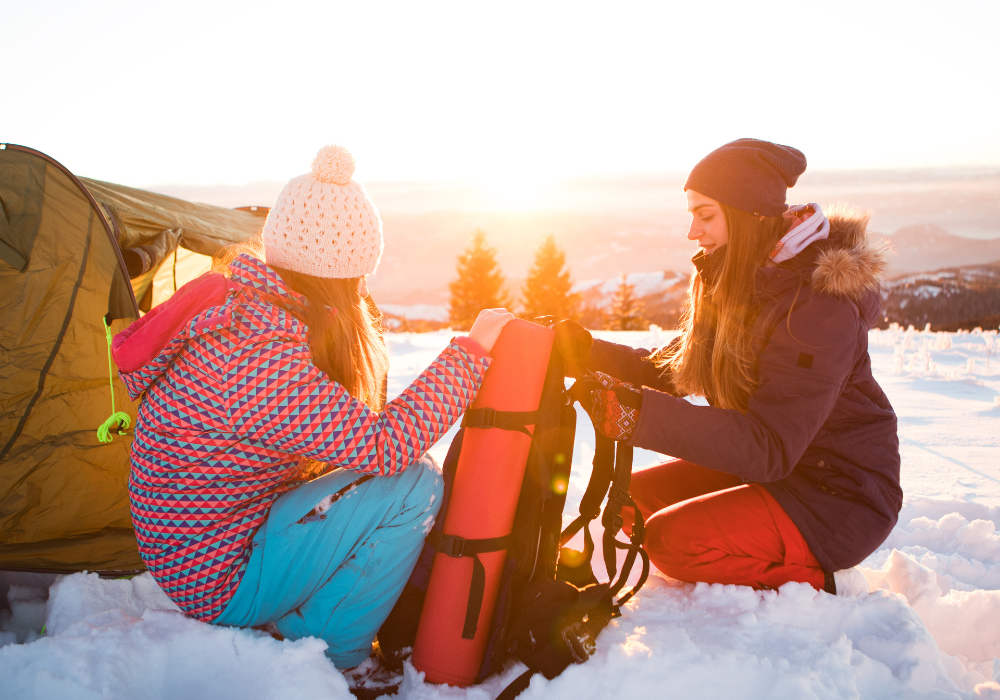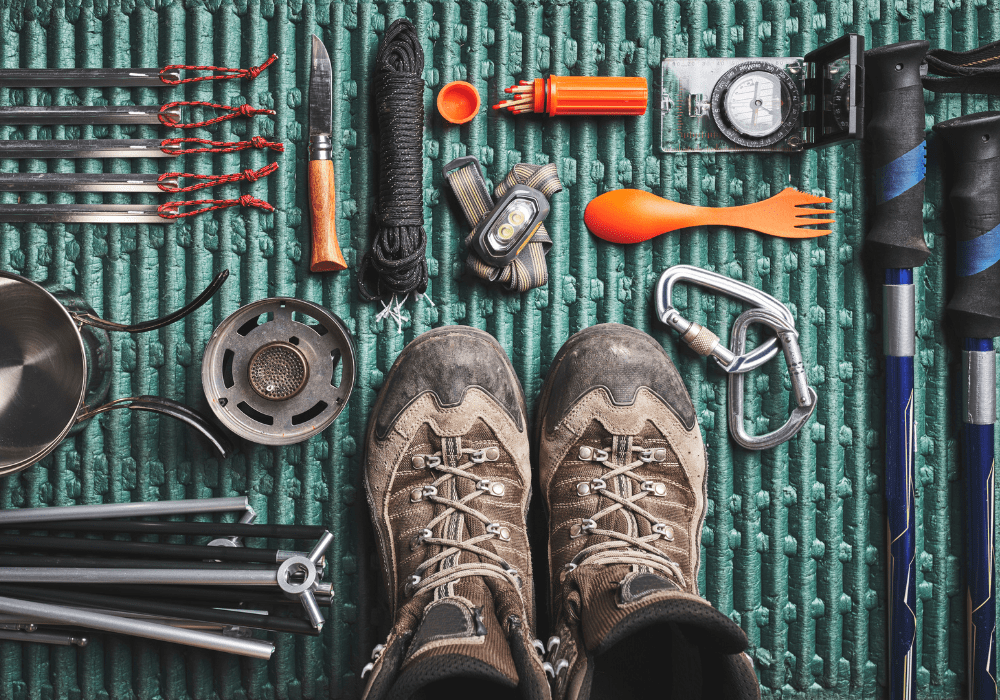
Camping Clothes Checklist to Keep You Covered!
What you wear while camping will contribute majorly to your comfort, safety, and overall enjoyment. This is why it’s important to wear and bring the right set of clothes on every camping trip.
Unfortunately:
There isn’t a universal set of camping clothes you can wear for every trip. The clothes you’ll need will largely depend on the climate and season in the place you plan to camp in.
Table of Contents
Camping Wear for All Seasons
If you’re planning to go camping and wondering what you need to wear on your trip, this article is for you. Below we lay out our suggestions for camping clothes for every season. At the bottom, we’ve included an easy-to-print quick checklist of all the items you see below.
Essential Winter Camping Wear
Winter is the coldest season of the year. It’s also the season with the shortest days and the longest nights. Depending on where you’re camping, winter can mean freezing winds, frequent chilling rains, and/or heavy snowfall.
If you want to go winter camping, you’ll need to dress in three or four layers of clothes.
40% to 50% of our body heat escapes from our heads and necks. To keep your body heat where it belongs, you can wear a winter hat. Skiers wear a balaclava or ski mask to save their faces from the cold and you can too.
You should also wear polarized sunglasses to protect your eyes from the glaring snow.
You can keep your neck and face warm by wearing a scarf or a neck gaiter. The latter also protects your face from wind burn.
As previously mentioned, you’ll want to wear three to four layers to keep your core temperature warm while also allowing you to take off/put on layers to adjust your temperature. You’ll want to wear a warm (polyester or fleece) long-sleeved layer closest to your body. You’re free to choose what to wear for your 2nd and 3rd layers but your final layer has to be a wind and waterproof shell jacket.
The need for layers extends to your lower body. Again, your next-to-skin layers have to be warm (like merino long johns) while your final layer has to be a pair of weatherproof shell pants.
For your hands, some warm fleece gloves under heavy-duty weatherproof gloves will be fine.
For your feet, multiple layers of socks inside a reliable pair of waterproof boots will do you good. Additionally, you can also wear some gaiters to keep water, dirt, grit, and trail debris from entering your shoes.
Essential Spring Camping Wear
Winter eventually gives way to spring. With this season comes moderate temperatures and more pleasant days for outdoor activities.
For headwear, you can wear anything you like. We do suggest having a bandana or neck gaiter with you since you can use it to keep hair and sweat away from your eyes. Sunglasses will protect your eyes from the Sun’s rays.
Since spring is warmer than winter, you won’t need to wear as many layers or dress as warmly.
You may want to wear a long-sleeved polyester t-shirt as a base layer. This keeps you warm while also wicking excess moisture away and gives some protection from mosquitoes.
Your outer layer can be a fleece jacket for warmth or a lightweight nylon jacket. Both options protect you from minor cuts and scrapes while moving to or in camp.
The same idea goes for your lower body: warm polyester long johns under a protective outer layer like soft shell pants.
For your hands, you can wear wool gloves for those particularly cool nights.
For footwear, you have a lot more options like sneakers, running shoes, or sandals. Whatever you choose, you may want to pair them with wool socks for warmth and moisture protection.
Essential Summer Camping Wear
After spring comes summer. This is the hottest season of the year and is the opposite of winter. It comes with longer days, shorter nights, and the occasional sudden rain shower.
With summer being the warmest and sunniest season, you’ll want to wear a breathable sun hat and sunglasses. There’s no single design for sun hats and sunglasses so you have lots of options.
If the heat becomes oppressively hot, you may want to wear a neck gaiter to protect your neck. Sunburn can make your nights uncomfortable so be sure to cover up. A neck gaiter can also help against those pesky mosquitoes.
For your body, you’ll want to wear something with good coverage from the Sun but still breathable, sweat-wicking, and quick-drying. You can achieve this by wearing a breathable, sweat-wicking, and quick-drying t-shirt (long or short-sleeved) underneath a lightweight short-sleeved shirt or hoodie. You’ll also need to carry a waterproof jacket for those unpredictable summer rain showers.
For your lower body, summer is the best time to wear quick-drying shorts. That said, you may want to save your legs from the Sun and wear UV-proof leggings underneath your shorts.
You won’t need much protection for your hands unless you need to climb some boulders to get to your campsite. In this case, you’ll need some lightweight gloves.
You have a lot of options when it comes to footwear. From running shoes to quick-drying hiking shoes to sandals, what you wear will depend on the terrain you need to handle. You can pair that with quick-drying and sweat-wicking socks underneath.
Essential Fall Camping Wear
After the hot summer months comes the season of fall. At this time, things start to cool down a bit as the season transitions to winter. Colder winds, fallen leaves, and darkening nights are what you can expect during this season.
During fall, you’ll want to keep body heat from escaping through your head and neck, though, you won’t need as much insulation as in winter. A wool beanie should do the trick.
If fall is particularly cold where you’re camping, you can bring a scarf or neck gaiter just in case.
The same rule for layering clothes in winter applies during fall:
Go for a warm (polyester or fleece) long-sleeved layer closest to your body and a weatherproof shell jacket for your final layer. You can wear a cotton or polyester t-shirt as your 2nd layer.
For your legs, wear merino long johns for your next-to-skin layer paired with some soft-shell pants.
For your hands, a pair of warm fleece gloves will do.
Depending on how cold fall is where you’re camping, you may need to wear layers of socks to keep your feet warm. Fall is warm enough for you to wear all-terrain hiking shoes or even lightweight trail running shoes.
Essential Camping Wear Quick Checklist
Here’s what you’ll need for camping in the following seasons:
Winter
- Winter hat
- Balaclava or ski mask
- Polarized sunglasses
- Scarf or neck gaiter
- Warm (polyester or fleece) long-sleeved shirt
- Weatherproof shell jacket
- Merino long johns
- Weatherproof shell pants
- Fleece gloves
- Weatherproof gloves
- Multiple layers of socks
- Waterproof boots
- Gaiters
Spring
- Bandana or neck gaiter
- Sunglasses
- Long-sleeved polyester t-shirt
- Fleece jacket or lightweight nylon jacket
- Polyester long johns
- Softshell pants
- Wool gloves (optional)
- Sneakers, running shoes, or sandals
- Wool socks
Summer
- Breathable sun hat
- Sunglasses
- Neck Gaiter
- Breathable, sweat-wicking, and quick-drying t-shirt (long or short-sleeved)
- Lightweight short-sleeved shirt or hoodie
- Waterproof jacket
- UV-proof leggings
- Quick-drying shorts
Fall
- Wool beanie
- Scarf or neck gaiter
- Warm (polyester or fleece) long-sleeved layer
- Cotton or polyester t-shirt
- Weatherproof shell jacket
- merino long johns
- Softshell pants
- Fleece gloves
- Layers of socks
- All-terrain hiking shoes or lightweight trail running shoes.




